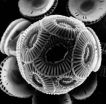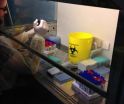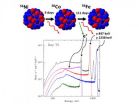(Press-News.org) Some species of marine phytoplankton, such as the prolific bloomer Emiliania huxleyi, can grow without consuming vitamin B1 (thiamine), researchers have discovered. The finding contradicts the common view that E. huxleyi and many other eukaryotic microbes depend on scarce supplies of thiamine in the ocean to survive.
"It's a really different way to think about the ocean," says CIFAR Senior Fellow Alexandra Worden, co-author on The ISME Journal paper with CIFAR fellows John Archibald (Dalhousie University), Adrián Reyes-Prieto (University of New Brunswick) and three lead authors from Worden's lab at the Monterey Bay Aquarium Research Institute, Darcy McRose, Jian Guo and Adam Monier.
All living creatures need thiamine to live, as well as other vitamins. Organisms may produce some of their own vitamins, the way that human cells create vitamin D with help from sunlight, but sometimes they rely on other organisms to produce the vitamins they need and then consume them. For example, oranges and other fruits produce vitamin C, which humans need in their diets.
Until now, many marine microbes with cells that have a nucleus — eukaryotes — were thought to depend on other organisms to produce thiamine. If this were the case, B1 would be a major factor in controlling the growth of algae such as E. huxleyi, whose blooms are sometimes so large you can detect them from space. But the researchers found that E. huxleyi grows equally well in water that contains a precursor chemical to thiamine, known as HMP, as it does in an environment rich with thiamine. In fact, it could grow without any thiamine at all.
"If we added thiamine or we added the intermediate, there was absolutely no difference in the growth rate. They were growing equally well," Worden says.
It was the discovery of a surprising biological mechanism that led the researchers toward this new understanding of thiamine. Genetic analysis had revealed 31 new eukaryotic riboswitches, which are segments of RNA that operate like mechanical switches to turn genes on or off. The researchers then found, unexpectedly, that the riboswitches were tied to genes of unknown function, not genes known to be connected with the production of thiamine. Further testing revealed these organisms didn't only have a taste for thiamine — they liked HMP too.
"Our study shows that conclusions regarding the importance of vitamin B1 in regulating algal communities need to be re-evaluated," Worden says.
This is the second recent study to find that vitamin B1 is less important than previously thought. Another paper in The ISME Journal published this August by Stephen Giovannoni's lab at Oregon State University found that the most abundant strain of bacteria in the ocean, SAR11, grows well in an environment with HMP but not with thiamine alone.
Biochemistry suggests HMP should be more stable than thiamine in the environment, but researchers must next investigate how plentiful the molecule is in the open ocean. Understanding how phytoplankton survive is crucial for predicting how climate change could alter the Earth's marine ecosystem; for example, as the supply of vitamins in the ocean depletes. Phytoplankton take up carbon dioxide and eventually sink to the bottom of the ocean, which makes their growth a major factor in how much carbon remains in the atmosphere.
"If you want to model the global carbon cycle and you're putting into the equation that external sources of this vitamin are needed and critical for certain algae (based on prior reports), that its availability shapes which phytoplankton will grow, your predictions will be incorrect," Worden says.
She says this study shows that marine researchers need to reconsider the methods they have relied on to understand the genetic processes by which ocean microbes adapt, evolve and survive. In the past these methods have been based largely on analogy to biochemical pathways as characterized in medically, industrially or agriculturally relevant organisms, i.e., "model organisms."
"What we need to recognize is that there might be some other piece to the puzzle, that is different from that in the characterized model organisms, especially when most, but not all of the parts known from model organisms are present," Worden says.
INFORMATION:
The research brought together three experts from CIFAR's Integrated Microbial Biodiversity program, which explores the diverse microbial world that surrounds and permeates human life. The CIFAR fellows involved came from various perspectives, with Archibald, a biochemist and molecular biologist, Worden's marine microbial ecology research group, and Reyes-Prieto, whose work is focused on the genetic analysis of microbial eukaryotes.
About CIFAR
CIFAR creates knowledge that will transform our world. The Institute brings together outstanding researchers to work in global networks that address some of the most important questions our world faces today. Our networks help support the growth of research leaders and are catalysts for change in business, government and society.
Established in 1982, CIFAR is a Canadian-based, global organization, comprised of nearly 350 fellows, scholars and advisors from more than 100 institutions in 16 countries. CIFAR partners with the Government of Canada, provincial governments, individuals, foundations, corporations and research institutions to extend our impact in the world.
Contact:
Lindsay Jolivet
Writer & Media Relations Specialist
Canadian Institute for Advanced Research
lindsay.jolivet@cifar.ca
(416) 971-4871
Not all phytoplankton in the ocean need to take their vitamins
2014-08-29
ELSE PRESS RELEASES FROM THIS DATE:
Ready for mating at the right time
2014-08-29
This news release is available in German. The exchange of chemical signals between organisms is considered the oldest form of communication. Acting as messenger molecules, pheromones regulate social interactions between conspecifics, for example, the sexual attraction between males and females. Fish rely on pheromones to trigger social responses and to coordinate reproductive behavior in males and females. Scientists at the Marine Science Center at the University of the Algarve in Faro, Portugal, and at the Max Planck Institute for Chemical Ecology in Jena, Germany, ...
China's reform of R&D budget management doesn't go far enough
2014-08-29
In almost 20 years, China's R&D expenditure as a percentage of its gross domestic product has more than tripled, reaching 1.98 per cent in 2012. This figure surpasses the 28 member states of the EU, which collectively managed 1.96 per cent.
However, despite this, China saw a sharp decline in money spent on scientific research, in particular applied research. Basic research funding plummeted from 5.2 per cent in 1995 to 4.7 per cent in 2011, and applied research funding fell from 26.4 per cent to 11.8 per cent in the same years.
This is Dr Cao's second Science article ...
Snails tell of the rise and fall of the Tibetan Plateau
2014-08-29
Boulder, Colo., USA - The rise of the Tibetan plateau -- the largest topographic anomaly above sea level on Earth -- is important for both its profound effect on climate and its reflection of continental dynamics. In this study published in GSA Bulletin, Katharine Huntington and colleagues employ a cutting-edge geochemical tool -- "clumped" isotope thermometry -- using modern and fossil snail shells to investigate the uplift history of the Zhada basin in southwestern Tibet.
Views range widely on the timing of surface uplift of the Tibetan Plateau to its current high ...
Science advice to governments comes of age at Auckland conference
2014-08-29
Auckland, New Zealand (29 August) — Science advice to governments has emerged as a discipline in its own right, which is both art and science. This is what delegates to the world's first summit of science advice heard at a meeting in Auckland, which closed today with a strong call to strengthen international collaboration, an agreement to formalise the network and meet again in 2016.
Convened by the International Council for Science (ICSU) and hosted by New Zealand's Chief Science Advisor, Sir Peter Gluckman, this historic summit marks a turning point in the global awareness ...
Intervention needed for survivors of childhood burns
2014-08-29
Adults who have been hospitalized for a burn as a child experience higher than usual rates of depression and suicidal thoughts, according to new research at the University of Adelaide.
A 30-year follow up of childhood burns victims has been conducted by the University's Centre for Traumatic Stress Studies. They found that 42% of people surveyed had suffered some form of mental illness and 30% suffered depression at some stage in their lives.
The results, now published in the journal Burns, also found that long-term depression was an issue among the group, and 11% had ...
Can YouTube save your life?
2014-08-29
Only a handful of CPR and basic life support (BLS) videos available on YouTube provide instructions which are consistent with recent health guidelines, according to a new study published in Emergency Medicine Australasia, the journal for the Australasian College for Emergency Medicine (ACEM).
Early recognition and treatment of sudden cardiac arrest are known to improve survival for
victims.
A team of Turkish emergency medicine specialists put together the study, which reviewed educational videos from the last three years accessed via YouTube when the search terms ...
Rapamycin or FK506, which is better for SCs migration and peripheral nerve repair
2014-08-29
FK506 possesses a well-studied neuroregenerative effect, stimulating neurite extension in the presence of nerve growth factor in vitro, and enhancing nerve regeneration following nerve crush injury and isografting. However, the use of FK506 to stimulate nerve regeneration is limited because of the risk of renal failure and hypertension, and its considerable cost. With long-term allografts, FK506 alone or combined with other drugs reportedly cause life-threatening infections. Like FK506, rapamycin is an immunosuppressant and FKBP-12-binding ligand, and has a neuroregenerative ...
MERS: Low transmissibility, dangerous illness
2014-08-29
The MERS coronavirus has caused disease outbreaks across the Arabian Peninsula and spread to Europe several times. The severe pneumonia virus has claimed the lives of several hundred people since its discovery in 2012. For a long time, scientists have been puzzled over how easily the pathogen spreads from human to human. An international team of researchers led by virologists from the University of Bonn have now come to the conclusion, through direct observation, that the rate of human transmission is low. Still, a third of infected persons with symptoms die. The results ...
Astrophysicists report radioactive cobalt in supernova explosion
2014-08-29
A group of astrophysicists, including researchers from MIPT, have detected the formation of radioactive cobalt during a supernova explosion, lending credence to a corresponding theory of supernova explosions. Details are given in the journal Nature, one of the most cited scientific publications in the world.
The article's main author, Yevgeny Churazov (Space Research Institute of the Russian Academy of Sciences), together with his co-authors, including Sergei Sazonov of the Space Research Institute and MIPT, reported the results of their analysis of data collected with ...
Cellphone addiction 'an increasingly realistic possibility,' Baylor study finds
2014-08-29
Women college students spend an average of 10 hours a day on their cellphones and men college students spend nearly eight, with excessive use posing potential risks for academic performance, according to a Baylor University study on cellphone activity published in the Journal of Behavioral Addictions.
"That's astounding," said researcher James Roberts, Ph.D., The Ben H. Williams Professor of Marketing in Baylor's Hankamer School of Business. "As cellphone functions increase, addictions to this seemingly indispensable piece of technology become an increasingly realistic ...




